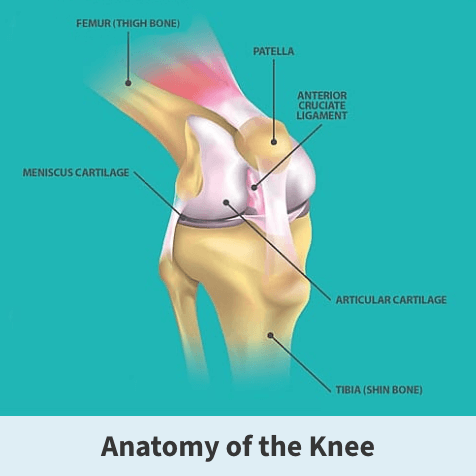Patellar fracture
A patellar fracture is a break in the kneecap (the patella) – the small bone that sits at the front of your knee. Because the patella acts as a shield for your knee joint, it is very vulnerable if you fall directly on it or hit it forcefully. A patellar fracture is a severe injury that can make it difficult or even impossible to straighten your knee or walk. This injury can be treated both surgically and non-surgically, depending on the type and severity of the fracture.
Anatomy

The patella is a small bone located in front of the knee joint located where the thighbone (femur) and shinbone (tibia) meet. It protects the knee and connects the muscles in the front of the thigh to the tibia. The ends of the femur and the undersides of the patella are covered with a smooth substance called articular cartilage, which helps the bones glide smoothly along each other as you move your knee.
About
The patella, also known as the knee cap, can fracture in many different ways from a variety of different causes. For example, a break can occur at the top, center, or lower part of the bone. The patella can also break in two clean pieces or many small pieces. The different types of fractures are as follows:
- Displaced fracture – In this type of fracture, the broken ends of the bone are separated and do not line up correctly and often need surgery to put the pieces of bone back together.
- Open fracture – In an open fracture, the bone breaks in such a way that bone fragments stick out through the skin. An open fracture often involves damage to the surrounding soft tissues and may take longer to heal.
- Comminuted fracture – In comminuted fractures, the bone shatters into three or more pieces. Depending on the specific pattern of the fracture, a comminuted fracture may be either stable or unstable.
Patellar fractures are usually caused by a brute force accident, like falling directly onto the knee or receiving a sharp blow to the knee. The kneecap can also be fractured indirectly. For example, a sudden contraction of the thigh muscles (quadriceps) can pull apart the patella.

Symptoms
Symptoms for kneecap fractures typically include:
- Pain and swelling in the front of the knee
- Bruising
- Inability to straighten the knee or keep it extended in a straight leg raise
- Inability to walk
Diagnosis
Your Florida Orthopaedic Institute physician will look at your symptoms and medical history, followed by a physical examination. During the exam, your physician will keep an eye out for the edges of the fracture that can often be felt through the skin, especially if the fracture is displaced.
Your physician will also check for hemarthrosis. In this condition, blood from the fractured bone ends collects inside the joint space, causing painful swelling. If you have a large amount of blood in your knee, your doctor may drain it to help relieve your pain.
Your physician may also order an X-ray to help confirm the diagnosis, which will produce images of dense structures in the body, such as bone.
Treatment
A patellar fracture can be treated both surgically and nonsurgically, depending on the type and severity of the fracture.
Nonsurgical treatments
If the bone pieces are not displaced, you may not need surgery. Your Florida Orthopaedic Institute physician may apply a cast or splint to keep your knee straight and help prevent motion in your leg. This keeps the broken ends of the bones in proper position while they heal.
Depending upon your fracture, you may also be allowed to bear weight on your leg while wearing a cast or brace. With some fractures, weight-bearing is not allowed for six to eight weeks.
Surgical treatments
If the pieces of bone are out of place (displaced), you will most likely need surgery. The type of procedure performed often depends on the type of fracture you have. Your Florida Orthopaedic Institute physician will determine which surgical procedure is best for you.
Two main types of fractures typically require surgery:
- Transverse fracture – This procedure treats fractures located near the center of the patella. These two-part fractures are most often fixed in place using screws or pins and wires and a “figure-of-eight” configuration tension band. The figure-of-eight band presses the two pieces together.
- Comminuted fracture – In some fractures, the patella is broken into several small pieces. This type of fracture occurs when the kneecap is first pulled apart from the injury and then crushed when the patient falls on it. Because the bone fragments are too small to be fixed back into place, your surgeon will remove them and then attach the loose patellar tendon back to the remaining patellar bone.

Pickleball for seniors: 10 tips for pain-free play
Videos
Related specialties
- ACL Injuries
- Arthroscopic Chondroplasty
- Articular Cartilage Restoration
- Deep Thigh Bruising
- Fractures of the Tibial Spine
- Iliotibial Band Syndrome
- Lateral Collateral Ligament (LCL) Injuries
- MACI
- Medial Collateral Ligament Injuries
- Meniscus Tears
- Muscle Spasms
- Muscle Strains of the Calf
- Partial Knee Replacement
- Quadriceps Tendon Tear
- Runner's Knee
- Senior Strong
- Shin Splints
- Total Knee Replacement Surgery
